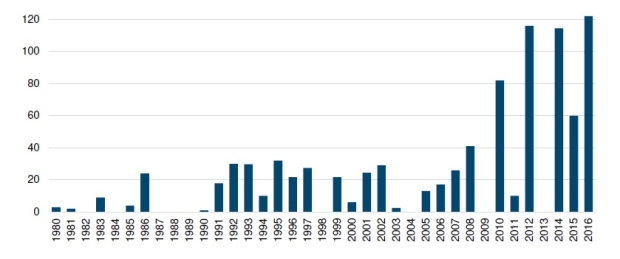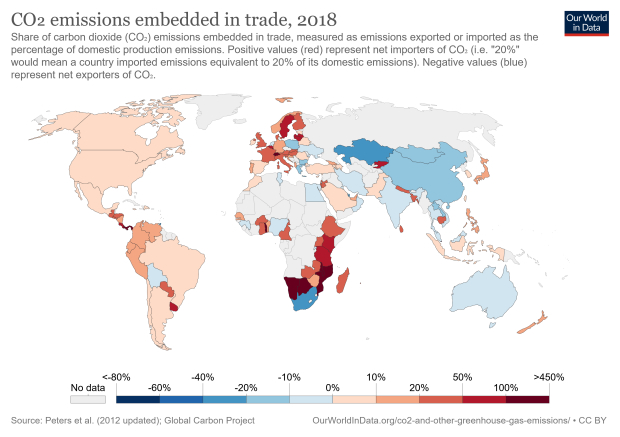Are EU trade agreements in line with the European Green Deal?
15 February 2021
New trade agreements promote sustainability, but enforceability and pricing of ‘pains from trade’ remain challenging.
By Julia Grübler, Roman Stöllinger und Gabriele Tondl
- Gains from trade are widely acknowledged, yet pains from trade need to be assessed more thoroughly.
- EU trade agreements are becoming ‘greener’ by including sustainability chapters. However, compared to other provisions, these chapters lack strong enforcement mechanisms.
- Adequate pricing of emissions and environmental damage is necessary to derive meaningful conclusions regarding the net benefits of regional trade agreements.
- Recently, many initiatives have been launched to make EU trade more sustainable. However, the alignment of trade policy with the European Green Deal is far from complete.
Environmental protection versus international trade
The adoption of the European Green Deal shifted climate protection and environmental sustainability into the focus of EU policies. Trade policy may be a crucial tool in achieving impact across EU borders. Its primary instruments are bi- and plurilateral free trade agreements (FTAs), which stretch all over the world.
The premise that FTAs, whose principal objective is to remove trade barriers between participating partners, can contribute to environmental and climate protection, seems surprising at first. After all, lower trade barriers usually mean more international trade and additional emissions related to increased production and transport services. Particularly in developing countries, facilitated access to new markets through FTAs often results in unintended negative environmental effects, e.g. through the establishment of monocultures or accelerated deforestation, which often goes hand in hand with export-oriented agricultural production.
Environmental provisions in trade agreements
In the European Commission's view, EU trade policy can effectively influence climate and environmental policies of partner countries . In recent years, the so-called ‘trade and sustainability chapters’ have found their way into the EU's FTAs as well as into its Generalised Scheme of Preferences (GSP) for developing countries. Since 2019, the EU also provides for the explicit inclusion of the Paris Agreement on Climate Change in its FTAs to mitigate global warming. In addition, the European Commission expects EU trade policy to facilitate trade in environmentally friendly goods and services and thereby to encourage respective investment
Average number of environmental norms covered in EU FTAs
Data source: Morin et al. (2018) – TREND database; authors’ calculations.
Lack of enforcement mechanisms
A major limitation to these ambitions is that FTAs lack the means to sanction trading partners for non-compliance with sustainability chapters. Following its ‘soft power’ approach – unlike the US – environmental provisions in EU FTAs are exempt from general dispute settlement mechanisms. Instead, consultation and expert panels are provided for to deal with disputes. The rationale is that trading partners will fulfil their obligations through monitoring and public pressure. Only one out of three existing GSP schemes (the so-called GSP+), currently applicable to eight countries only, allows the EU to withdraw trade preferences from partner countries if they fail to meet their environmental commitments.
Environmental sustainability and WTO reform
The existing multilateral rules of the World Trade Organization (WTO) are one reason for the lack of enforceability. Specifically, the current classification of ‘like products’ does not allow for the differentiation of tariff reductions and market access by production criteria. Only the labelling of goods, enabling consumers to make sustainable purchasing decisions, is allowed under the WTO. However, the possibility of eliminating tariffs on these products could have a much more significant impact on sustainable economic activities in partner countries.
WTO negotiations on an environmental goods agreement failed in 2016. With the new Biden administration, the dismissive attitude of the US towards the WTO and international environmental agreements might change. However, concerns prevail, as expressed by China, about opportunities for other emerging economies to free-ride. Major economies, such as India and Brazil, could benefit from concessions made by members of the agreement on a most-favoured nation basis, without having to commit themselves to liberalising their domestic markets for environmental goods. Overall, a revival is not in sight in the near future. Therefore, the EU would need to take a leading role, thus also taking on the risk of trade diversion.
Gains from FTAs need to be contrasted with negative environmental effects
The introduction of environmental provisions in FTAs has the potential to increase the variety of sustainable products, promote the development of the environmental goods sector and spread higher environmental standards and green technologies internationally. However, FTAs also aim to expand trade and therefore inevitably lead to additional emissions. The example of the EU-Mercosur FTA shows that a considerable portion of the economic gains from free trade is lost due to additional CO2 emissions. Taking the IMF’s proposal for an ‘adequate’ price of EUR 75 per tonne of CO2, a new FIW-wiiw study shows that the EU's gains from trade liberalisation would be reduced by 15% and Brazil's by 6%, respectively.
Due to data limitations, it is de facto not possible to quantify all the environmental costs associated with international trade that need to be compared to ‘gains from trade’. Therefore, it is ultimately a question of political priorities to find a compromise between the conflicting interests of trade expansion on the one hand and climate and environmental protection on the other.
Sustainable free trade agreements coherent with other EU policies
Conflicts of interest are immanent. However, it is possible to anchor environmental protection provisions much more firmly in the EU FTAs – as envisaged in the Green Deal – and to make them sanctionable. Sanctions should extend to the suspension or termination of an agreement. Other essential measures would be to intensify dialogue with partner countries on the ecological impact, for example, of monocultures or large-scale deforestation, and to provide the necessary financial resources for adaptation measures. EU companies should be made more accountable for complying with EU production standards in terms of environmental sustainability, also in their activities abroad. Worth mentioning in this context is the new EU ‘conflict minerals’ regulation effective from 1 January 2021 ‘laying down supply chain due diligence obligations for Union importers of tin, tantalum and tungsten, their ores, and gold originating from conflict-affected and high-risk areas’. In many areas, such as the timber industry or fish farming, labelling obligations could be used more widely. Self-restrictions, such as the new EU rules on trade with plastic waste – are important steps in this direction.
Consistency between EU trade policy and the Green Deal
It is not yet clear how the goals of deep and comprehensive FTAs with non-European partners are compatible with the Green Deal. The majority of non-European trading partners do not have any CO2 taxation mechanism, i.e. neither direct emissions taxes nor an emissions trading scheme. In this context, the Green Deal mentions a CO2 border adjustment tax for selected sectors as an option. However, this could possibly stand in the way of concluding comprehensive FTAs, as these aim to eliminate tariffs for the majority of products.
Balancing these tensions can certainly be seen as a real test for the European Green Deal and the transformation of the EU into a sustainable economy.


